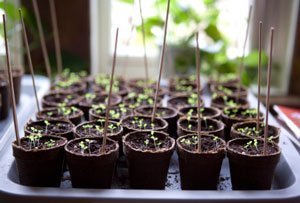 For slow maturing plants and gardeners with short growing seasons, starting seeds indoors can be a crucial element to achieving success. To figure out the optimal time to start your seeds indoors, all you really need is a bit of backwards thinking.
For slow maturing plants and gardeners with short growing seasons, starting seeds indoors can be a crucial element to achieving success. To figure out the optimal time to start your seeds indoors, all you really need is a bit of backwards thinking.
To find your zone in North America, visit the National Arboretum's website at:
International gardeners can find maps of their zones here:|
Average Dates of Last Frost (North American Zones) | |
| Zone 1: | June 1-June 30 |
| This zone remains vulnerable to frost 365 days per year. | |
| Zone 2: | May 1-May 31 |
| Zone 3: | May 1-May 31 |
| Zone 4: | May 1- May 31 |
| Zone 5: | March 30-April 30 |
| Zone 6: | March 30-April 30 |
| Zone 7: | March 30-April 30 |
| Zone 8: | February 28-March 30 |
| Zone 9: | January 28-February 30 |
| Zone 10: | January 30 or before. |
| Zone 11: | Frost-free year round. |
As you can see, the above list illustrates a 4-week range of potential last frost dates for each zone. Many gardeners in lower zones like to use the earliest dates in the range. This is probably a good strategy if your growing season is on the shorter side. Higher zones may want to start seeds somewhere in the middle of the 4-week period. No matter what your zone, make sure you factor in an extra week for hardening seedlings off before moving them permanently outdoors.
To get the best picture of trends on your area, contact your county extension agency, or ask a local nursery. The best way to calculate the last average frost date for YOUR garden is to keep a journal and watch the trend over several seasons.
| Plant | Number of Weeks Before Last Frost to Start Indoors |
| artichoke | 10-12 |
| ageratum | 8 |
| alyssum | 8 |
| aster | 6 |
| balsam | 6 |
| basil | 6-8 |
| batchelor button | 4-6 |
| begonia | 12 or more |
| broccoli | 8 |
| browallia | 12 or more |
| brussels sprouts | 7-8 |
| cabbage | 5-7 |
| cauliflower | 8 |
| catnip | 8-12 |
| calendula | 6-8 |
| cantaloupe | 3-4 |
| celery | 7-12 |
| celosia | 8 |
| centurea | 8 |
| chamomile | 8-12 |
| chervil | 6-8 |
| chives | 12-14 |
| coleus | 8 |
| collards | 5-7 |
| columbine | 8 |
| coriander | 6-8 |
| cosmos | 4 |
| cucumber | 4 |
| dahlia | 8 |
| daisy | 6-8 |
| dianthus | 10 |
| dill | 6-8 |
| eggplant | 8 |
| feverview | 8-12 |
| fuchsia | 18-20 |
| geranium | 12 or more |
| impatiens | 10 |
| kale | 4-6 |
| lemon balm | 6-8 |
| larkspur | 12 or more |
| leeks | 10-12 |
| lettuce | 8 |
| lobelia | 12-14 |
| marigold | 6 |
| mint | 12-14 |
| muskmelon | 4 |
| nasturtium | 4-6 |
| nicotiana | 8 |
| okra | 2-4 |
| onion | 10-12 |
| oregano | 12-14 |
| pansy | 12 or more |
| parsley | 12-14 |
| peppers | 8 |
| petunia | 10 |
| phlox | 8 |
| poppy | 12-14 |
| portulaca | 10 |
| pumpkin | 2-4 |
| sage | 6-8 |
| savory | 6-8 |
| snapdragon | 10 |
| spinach | 6-8 |
| squash | 4 |
| stock | 10 |
| Swiss chard | 6-8 |
| thyme | 8-12 |
| tomato | 6 |
| verbena | 10 |
| vinca | 12 or more |
| watermelon | 5-6 |
Tip: Don't discard your half-used seed packets from last year! Many of them will stay viable for several years if your keep them stored in a cool, dry place. Here is a brief list of the life expectancy of some common vegetable seeds.
| Plant | Seed Life Exptectancy |
| beans: | 3 years |
| beets: | 4 years |
| broccoli: | 3 years |
| cabbage: | 4 years |
| carrots: | 3 years |
| cauliflower: | 4 years |
| corn: | 2 years |
| cucumber: | 5 years |
| eggplant: | 4 years |
| lettuce: | 4 years |
| onions: | 1 year |
| peas: | 3 years |
| peppers: | 2 years |
| radishes: | 5 years |
| spinach: | 3 years |
| squash: | 4 years |
Thanks Ellen, this is valuable information!!!